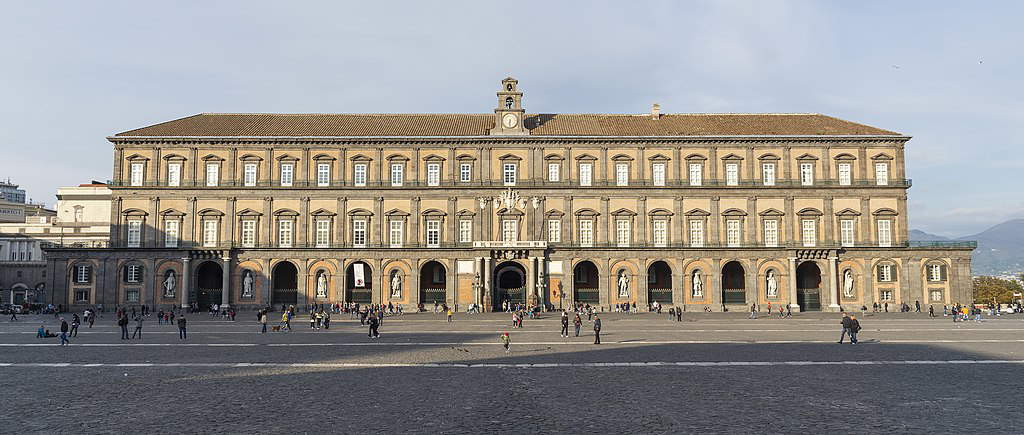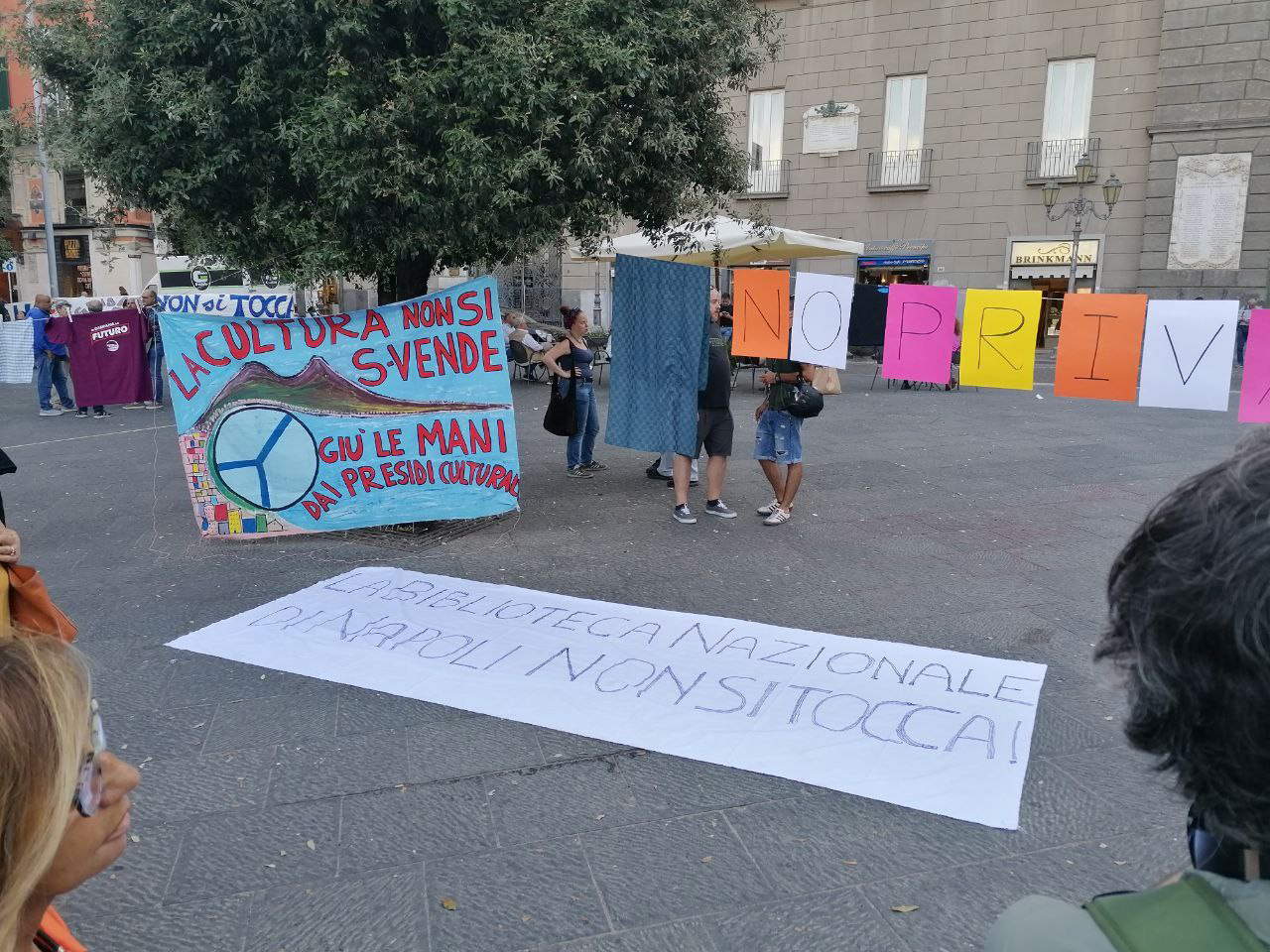Culture ministers (or equivalent) from more than twenty Mediterranean countries met in Naples on June 16 and 17. A meeting strongly desired by Italian Minister Dario Franceschini, who commented, “to make this journey together we must increase the circulation of talents and cultural professionals, commit ourselves together to the protection of cultural heritage, and take up the challenges and opportunities of the green and digital traditions. Naples is the ideal setting from which to start this journey.” For such an important event, the minister chose the venue of the Royal Palace, the building commissioned by Philip III of Spain and grown up between the 17th and 19th centuries, which has been a national museum since 1919 and the home of the National Library of Naples since 1927. For the occasion, the museum has been closed since Monday, June 13, and will be closed until June 23; the Library is closed from June 16 until Tuesday, June 21; and on June 16 and 17, Piazza Plebiscito, which the palace overlooks, was armored by 250 officers. This is a way to forestall the expected protests, given that right inside the Royal Palace lurks one of the most active cultural disputes in recent weeks: the one calling for the National Library not to be moved from its historic location.
This is the third time the minister has passed through the Neapolitan city for public events in less than three months: on April 26, to present his book; on May 20, to receive the keys to Pompeii and for the opening of Intesa Sanpaolo’s new Gallerie d’Italia; and precisely on June 16 and 17 for this ambitious international meeting. Each visit was accompanied by bombastic statements. During the last one, he explained how he sees Naples as having a future role as the “permanent cultural capital of the Mediterranean,” but he also talked about the now decades-old project of a high-speed train station that would bring tourists to the front of the Pompeii excavations; of the move of the National Library from its current location at the Royal Palace to the Real Albergo dei Poveri at Palazzo Fuga; and again of a Totò museum at Monte di Pietà, a project also reiterated a few days later in a tweet following the death of the artist’s daughter, Liliana de Curtis. During this latest visit, the Totò museum was joined by a proposal for a museum to Enrico Caruso, aimed at filling the part of the Royal Palace that will no longer be occupied by books. An economic focus as well, with 100 million from the PNRR for the Real Albergo dei Poveri, 8 million for Castel dell’Ovo, and a few tens of millions, not yet defined, that will be needed to complete the purchase and renovation of Monte di Pietà.
But not everything is going as planned, and as evidence of this, a group of citizens and associations have challenged the turn that, with the help and collaboration of the city administration, Franceschini is trying to give to the city: in Piazza del Municipio, where the police headquarters has granted the garrison (600 meters from the Royal Palace), very different realities have met, in addition to citizens who have taken the cause to heart: Mi Riconosci, NapoliMonitor, SET - Sud Europa Turistificazione, Scugnizzo Liberato, GRIDAS - Gruppo Risveglio dal Sonno, Ex opg - je so’ pazzo, La Biblioteca Nazionale di Napoli non si tocca, Demanio Costituzionale, L’ASILO - ex Asilo Filangieri, Forum Cultura Napoli, Italia Nostra Napoli, Comitato civico di Santa Maria di Portosalvo - Napoli, Giardino Liberato di Materdei.




The relocation of the National Library from the Royal Palace, useful for clearing rooms to obtain more space for private and institutional events-such as the one that took place-has immediately met with opposition from users, citizens and the library workers themselves, who created the committee "The National Library of Naples is not to be touched." they find it inconceivable to plan a tens of millions of euros move out of the center, in a situation where the library cannot guarantee afternoon openings, and risky the project of moving such valuable volumes without a structured plan. The high-speed rail hub in Pompeii, aimed at depositing tourists within walking distance of the excavations, while the circumvesuviana rail line is in such a state of disrepair that it has become a laughingstock on social media, is bound to find opposition from mayors and citizens of the entire area, who would see-even more than now-hundreds of thousands of tourists visiting the park without leaving anything more to the surrounding area and towns: a project with no future in a time of a push for slow and widespread tourism. While on the Museums of Totò and Caruso, at Monte di Pietà or wherever they will be destined, information is still too little and vague to be contested: but vagueness itself is an issue. Moreover, there is already a museum dedicated to Enrico Caruso: it is the birthplace of the great tenor, opening in August 2021.
These doubts, or these explicit oppositions that exist in the city with respect to the ministerial plans, are grafted and intertwined with those concerning the revolution that is planned for the management of municipal cultural institutes. The junta in January made clear its intention to give them under management to a foundation created ad hoc, on the model of the civic museums of Venice, but, whether because of the knowledge of what happened in the city Veneto between 2020 and 2021 (where, in order to guarantee the foundation’s budgets, the museums remained closed or with very reduced hours for many months, so as to be able to keep the staff laid off), or because of the fact that this transformation would impose the payment of a ticket for spaces that have always had free access to citizens, such as Castel dell’Ovo, the project has met with criticism from a wide range of associations and committees, from Italia Nostra to Legambiente, which on March 30 launched a petition and sent a letter to the newspapers, which just in the days of the Mediterranean meeting found further space. Two worlds, two different disputes that intersected around the Royal Palace, bringing some 80 people to the Town Hall Square, while witnessing the attempt to develop a political and imaginative humus that should allow the city to digest the revolution without a blow, indeed with appreciation. “We are open to discussion, but without aggression,” Dario Franceschini explained to the press in reference to the June 16 protests: yet that very same dialogue had been denied by calling for the protest garrison to be moved elsewhere.
“We have created a transversal network, bringing even very different realities to the square but all agreeing on one point: we want cultural garrisons, proximity libraries, civic participation in decision-making processes, we want the National Library to remain where it is, we want Castel dell’Ovo to remain free and free,” said Marina Minniti of Mi Riconosci “This is the second garrison we are organizing and we will not stop until we are heard,” she concluded. While the activists and activists of the La biblioteca nazionale di Napoli non si tocca committee say they are “happy to see so many people in the square supporting our cause, the library over the years has played a fundamental role for the citizens who recognize it and today are ready to defend it.” Will the new Totò and Caruso museums be enough to appease the city’s cultural and social fabric? The coming months will tell.
Warning: the translation into English of the original Italian article was created using automatic tools. We undertake to review all articles, but we do not guarantee the total absence of inaccuracies in the translation due to the program. You can find the original by clicking on the ITA button. If you find any mistake,please contact us.